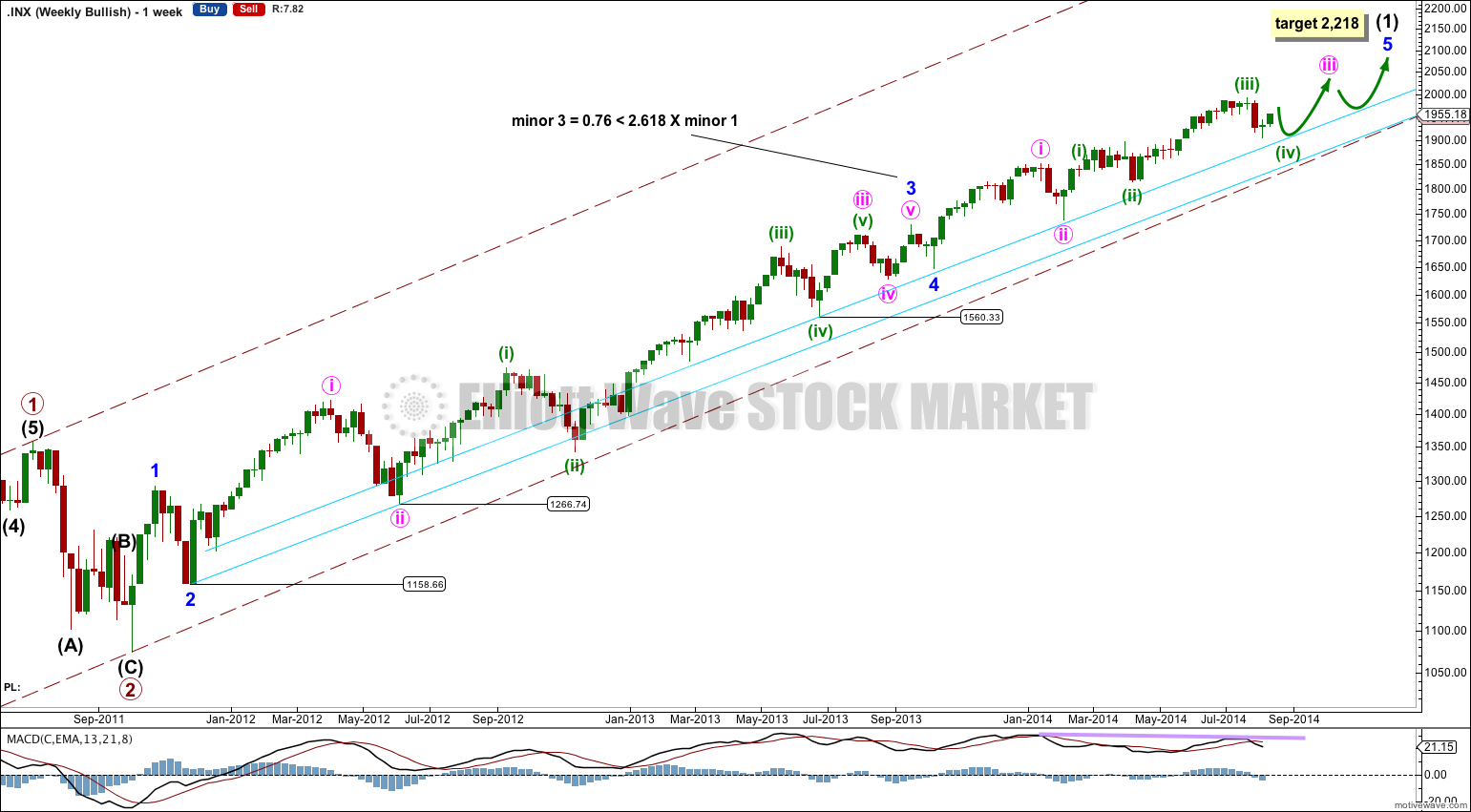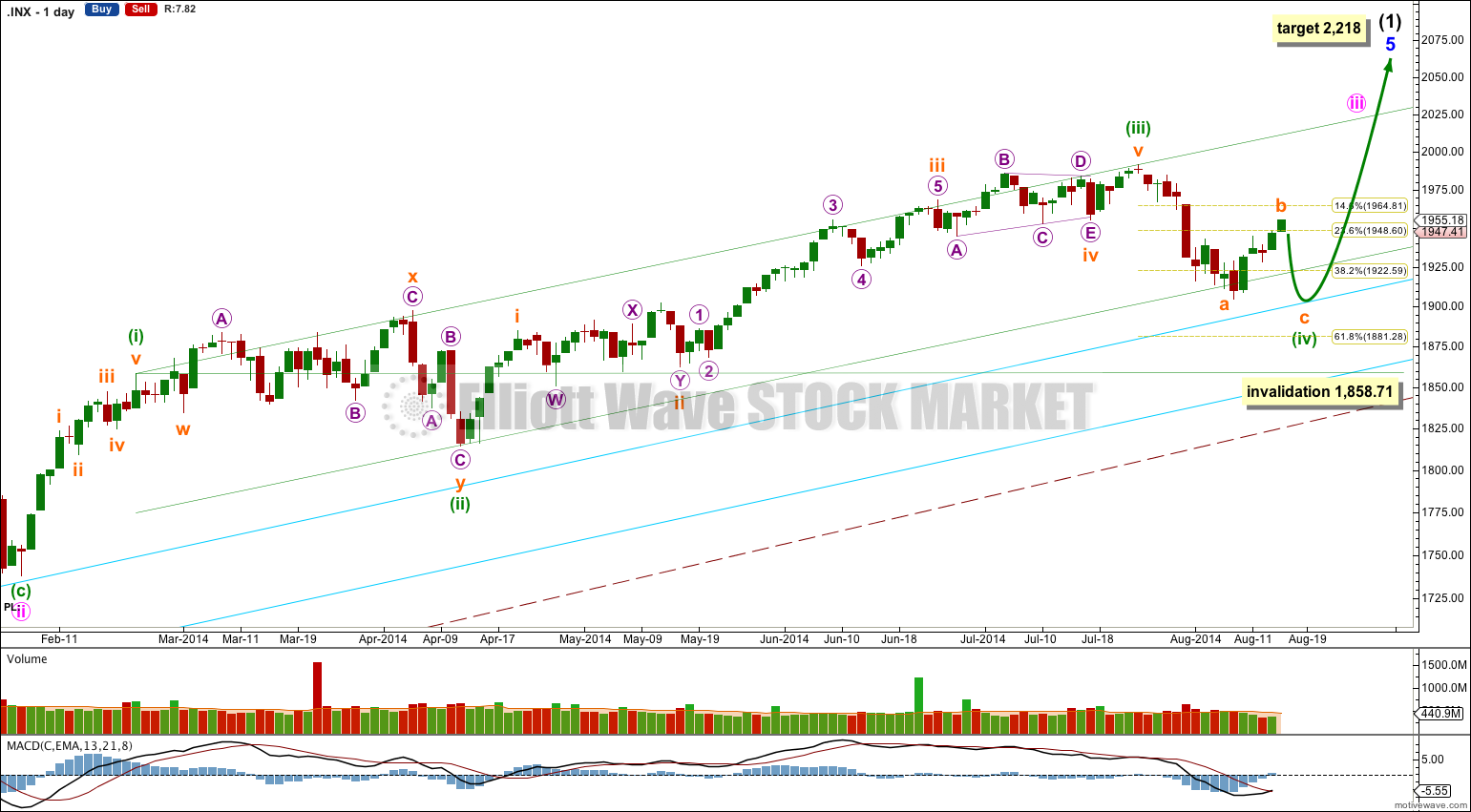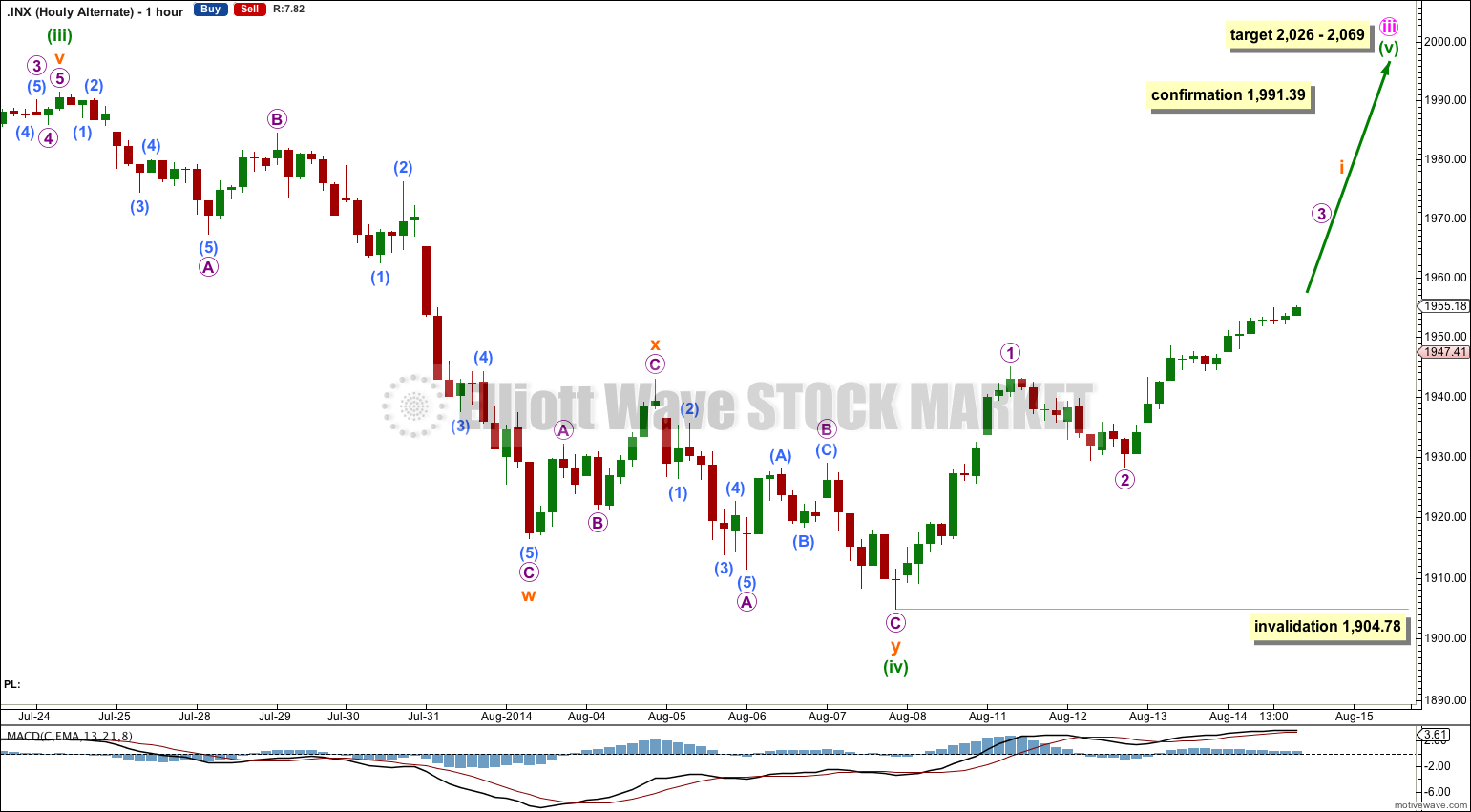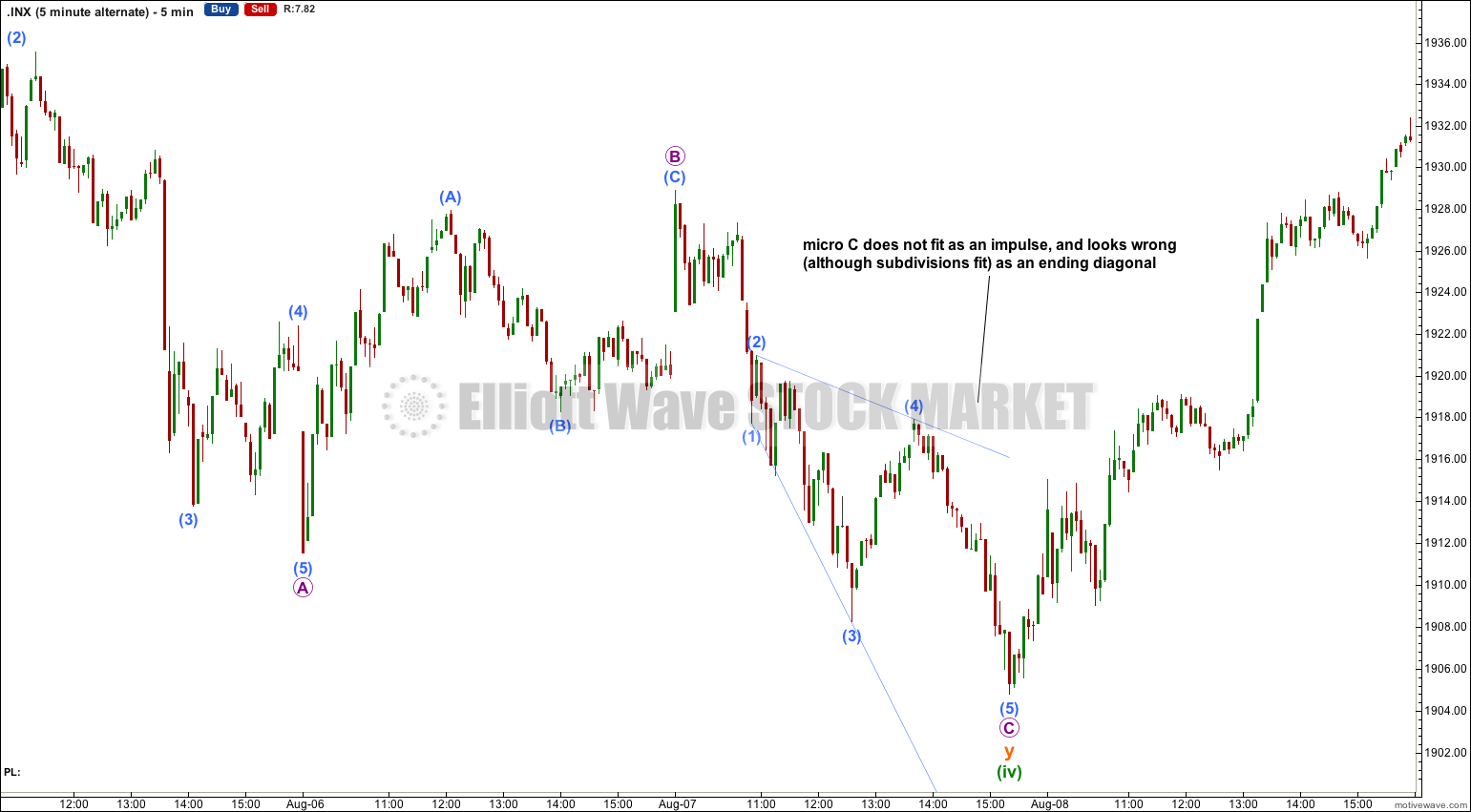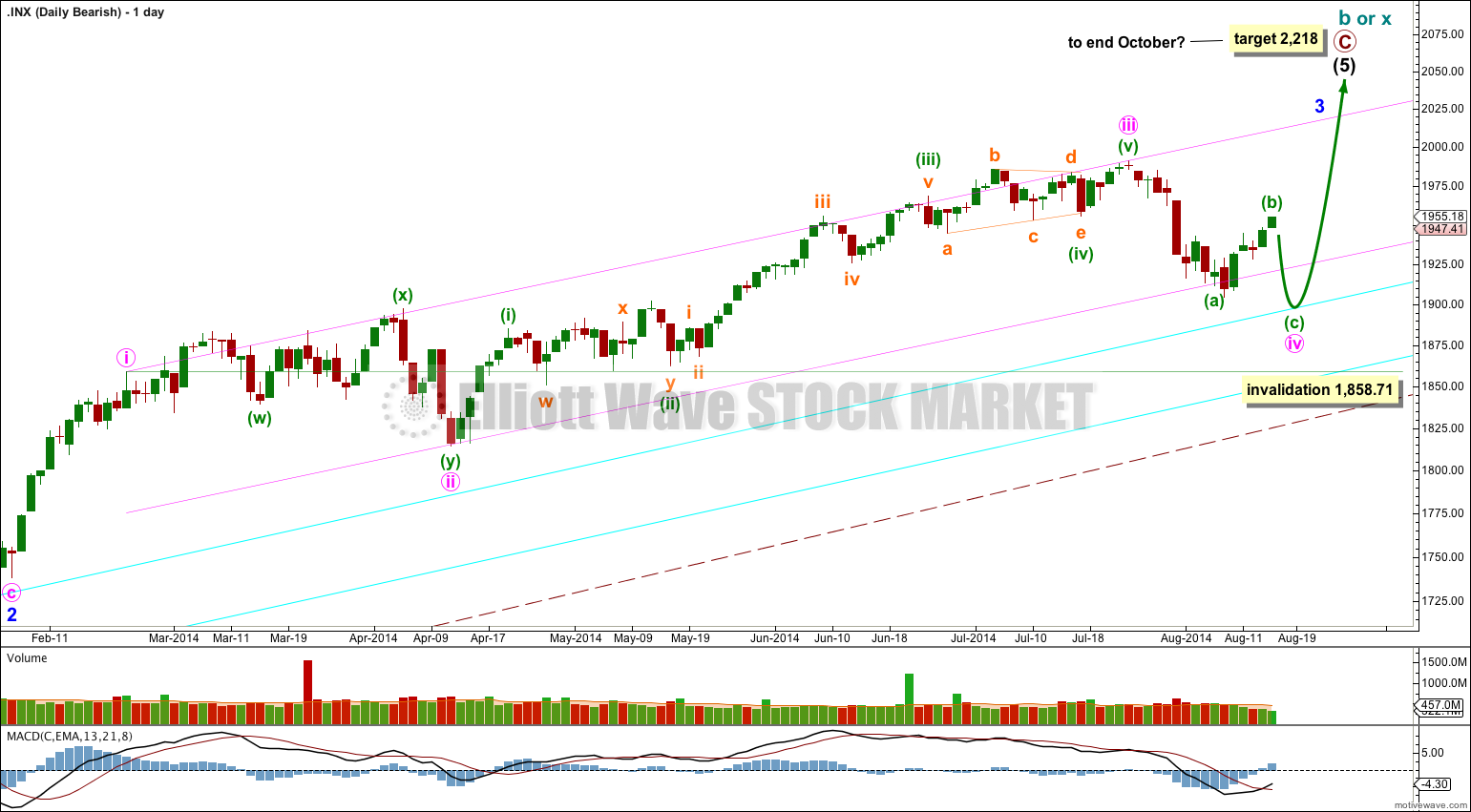Yesterday’s Elliott wave analysis expected slight upwards movement to a short term target at 1,952. Price moved higher than expected reaching up to 1,955.23.
Summary: It is still most likely that minuette wave (iv) is incomplete. I expect downwards movement to a target at 1,905 to be met in six days time. We could see a couple more days of sideways movement before the final wave down.
Click on charts to enlarge.
Bullish Wave Count.
The bull wave count expects a cycle wave IV was over at the end of the credit crunch and a new bull market for cycle wave V began there.
The maroon channel is a base channel about primary waves 1 and 2. That primary wave 3 began two years and eight months ago and still has not broken above this channel, as it should, gives some cause for concern with this wave count. That is why I still follow the bearish wave count idea.
I will not label primary wave 3 as either over or nearing completion while it does not breach the upper edge of this base channel because that would have the wrong look.
At 2,917 primary wave 3 would reach 2.618 the length of primary wave 1. It must break above the upper edge of the base channel for this wave count to have the right look.
I have noticed an interesting relationship with RSI and big trend changes over the last few years for the S&P. Prior to each major high RSI had moved above 70. Prior to each major low RSI had moved below 30. At each major high RSI moved above 70 more than a year before the high was reached, and it showed divergence with price.
RSI moved above 70 back in February 2013, more than a year ago, but RSI has not yet shown divergence, and has not made a last final failure swing. If it follows that these two things happen then I would consider that strong indication that the bear wave count may be correct.
October and March seem to be common months for major turning points in the S&P over the last several years. I will look to this October as a possible high. It may be that intermediate wave (1) ends there.
This weekly chart shows more detail of intermediate wave (1).
The aqua blue trend lines are critical. Draw the first trend line from the low of 1,158.66 on 25th November, 2011, to the next swing low at 1,266.74 on 4th June, 2012. Create a parallel copy and place it on the low at 1,560.33 on 24th June, 2013. While price remains above the lower of these two aqua blue trend lines we must assume the trend remains upwards. This is the main reason for the bullish wave count being my main wave count.
There are a couple of things about this wave count of which I am confident. I see minor wave 3 within intermediate wave (1) as over at 1,729.86 (19th September, 2013). It has the strongest upwards momentum and is just 0.76 longer than 2.618 the length of minor wave 1. At 455 days duration this is a remarkably close Fibonacci ratio. The subdivisions within it are perfect. If this is correct then minor wave 4 ends at 1,646.47 and this is where minor wave 5 begins.
Minor wave 5 is unfolding as an impulse. If minor wave 5 has passed its middle then I would expect to see more divergence between price and MACD develop over coming weeks.
Along the way up towards the final target I would expect to see two more corrections complete: the current correction for minuette wave (iv) and one more for minute wave iv.
Minuette wave (iv) may not move into minuette wave (i) price territory below 1,858.71.
At 2,218 minor wave 5 would reach equality in length with minor wave 3. This target may be met in October.
I have drawn a parallel channel about minute wave iii using Elliott’s first technique: draw the first trend line from the highs of minuette waves (i) to (iii), then place a parallel copy on the low of minuette wave (ii). Minuette wave (iv) so far slightly breaches the lower edge of this channel, and at its end I expect another small breach. This may indicate an overthrow of the channel on the opposite side for the upcoming fifth wave.
Minuette wave (iv) may reach as low as the 0.618 Fibonacci ratio of minuette wave (iii) at 1,881.28, which would provide alternation in depth of correction between minuette waves (ii) and (iv), (minuette wave (ii) was a shallow 37% correction). Downwards movement may find final support about the upper aqua blue trend line, continuing a pattern which has lasted about a year now. If the upper aqua blue trend line is overshot by downwards movement then I would expect price to find support at the lower aqua blue trend line, although it may not get that low.
Minuette wave (ii) lasted exactly a Fibonacci 34 sessions. So far minuette wave (iv) has lasted 14 sessions, and if it continues for another seven it will last a Fibonacci 21 sessions and have a 0.618 Fibonacci ratio to the duration of minuette wave (ii).
The large maroon – – – channel is copied over from the weekly chart. It is drawn in exactly the same way on bull and bear wave counts. For the bull wave count this channel is termed a base channel about primary waves 1 and 2. A lower degree second wave should not breach the lower edge of a base channel drawn about a first and second wave one or more degrees higher. The lower maroon – – – trend line differentiates the bull and bear wave counts at cycle degree and monthly chart level.
Main Hourly Wave Count.
For reasons explained on the alternate hourly chart below this main wave count still has a higher probability, despite subminuette wave b moving higher than expected from yesterday’s analysis.
Subminuette wave a fits perfectly as a five wave impulse. Subminuette wave b may be a complete double combination (flat – X – zigzag) or the second structure of micro wave Y may be an incomplete flat or triangle. In that scenario we could see another day or two of sideways movement before subminuette wave c begins.
If subminuette wave b is over as a double combination then it has an atypical look. The second structure in the double deepens the correction, when normally the second structure only moves sideways. However, combinations for the S&P 500 do not always have the most typical look (see the example of minuette wave (ii) on the daily chart where the second structure moves comfortably below the end of the first).
If subminuette wave b is over then at 1,905 subminuette wave c would reach 0.618 the length of subminuette wave a and downwards movement would find the upper aqua blue trend line on the daily chart.
Because subminuette wave a subdivides as a five wave impulse minuette wave (iv) is a zigzag. Within the zigzag subminuette wave b may not move beyond the start of subminuette wave a above 1,991.39.
Alternate Hourly Wave Count.
Could minuette wave (iv) be over? If it is then it would fit best as a double zigzag. The problem with this wave count, and it is highly significant, is the structure of the final wave of micro wave C within subminuette wave y. This downwards movement does not fit at all as a five wave structure (either impulse or ending diagonal) on the five minute chart and the hourly chart. It fits very well indeed as a three.
Any wave count which sees minuette wave (iv) as over has to see that last wave down as a five. This has a very low probability, maybe as low as 5%. I attach the 5 minute chart for this piece of movement so you may judge for yourselves.
I will certainly allow for the possibility that I could be wrong, that this fourth wave correction is actually over and my analysis of it is incorrect. This alternate would be confirmed with movement above 1,991.39.
At 2,026 minuette wave (v) would reach equality in length with minuette wave (i). At 2,069 minute wave iii would reach 1.618 the length of minute wave i. This gives a rather wide target zone though and may be narrowed towards the end when the target can be calculated at subminuette wave degree as well.
Within minuette wave (v) no second wave correction may move beyond the start of its first wave below 1,904.78.
Bearish Alternate Wave Count
Cycle wave b (or x) is now longer than the maximum common length of 138% the length of cycle wave a. This reduces the probability of this wave count to an alternate. However, that is the only problem I can see at all with this wave count.
Within the zigzag upwards of cycle wave b (or x) primary wave C remains within the corrective channel and sits in the lower half. This fits nicely for this bearish wave count.
If the target at 2,218 is reached then cycle wave b (or x) would be 180% the length of cycle wave a. At 2,393.39 cycle wave b (or x) would be twice the length of cycle wave a (or w) and the probability of this wave count would then be so low it should be discarded.
The maroon channel is here a corrective channel about the upwards zigzag. When this channel is breached by downwards movement that would provide trend channel confirmation that cycle wave b (or x) is over and cycle wave c (or y) has begun.
If RSI begins to show divergence and then makes a failure swing in October this wave count could see a trend change in that month.
This bearish alternate wave count expects that the correction is not over. The flat correction which ended at 666.79 was only cycle wave a (or w) of a larger super cycle second wave correction.
The structure and subdivisions within primary wave C for the bear wave count are the same as for intermediate wave (1) for the bull wave count. Thus the short to mid term outlook is identical.
The differentiation between the bull and bear wave count is the maroon – – – channel. The bull wave count should see price remain above the lower maroon – – – trend line. The bear wave count requires a clear breach of this trend line. If this trend line is breached by a full weekly candlestick below it and not touching it then this bear wave count would be my main wave count and I would then calculate downwards targets.
We should always assume the trend remains the same until proven otherwise; the trend is your friend. While price remains above the lower maroon – – – trend line I will assume that the S&P 500 remains within a bull market.
This analysis is published about 08:20 p.m. EST.


